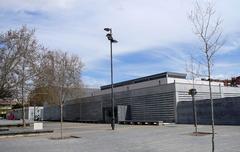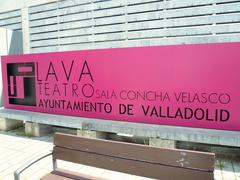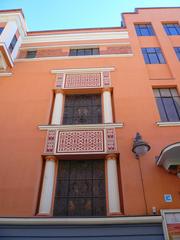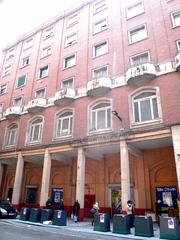
Convento de San Francisco Valladolid: Visiting Hours, Tickets, and Historical Significance
Date: 04/07/2025
Introduction: Unveiling Valladolid’s Lost Treasure
The Convento de San Francisco once dominated Valladolid’s cityscape as a monumental Franciscan complex with deep spiritual, artistic, and political influence. Founded in the 13th century, it served as a religious and social hub for centuries, boasting Gothic, Renaissance, and Baroque architectural splendors. Though demolished in the 19th-century Desamortización, its legacy remains a cornerstone of Valladolid’s cultural memory, and its historical footprint can still be traced through urban toponymy, museum collections, and nearby religious sites (UVaDoc, 1985; Info Valladolid).
Today, the vibrant Plaza Mayor covers the convent’s former grounds, offering a lively urban experience where echoes of the past persist. While the convent itself is gone, visitors can delve into its story via nearby museums, churches, and guided tours, gaining insight into Valladolid’s monastic traditions and artistic heritage (Museo Nacional de Escultura; Turismo Valladolid).
This guide provides an in-depth exploration of the Convento de San Francisco’s history, visitor information, accessibility considerations, travel tips, and recommended nearby attractions. Whether you’re a history enthusiast or a cultural traveler, discover how to connect with Valladolid’s monastic legacy and plan your visit with confidence.
Quick Visitor Information
- Location: Plaza Mayor, Valladolid city center
- Convent Status: Demolished in the 19th century; site is now an open public plaza.
- Ticket Info: No entrance fee for Plaza Mayor; nearby museums with convent artifacts may require admission (check individual websites).
- Getting There: Easily accessible on foot from the train station, by bus, taxi, or bike.
- Accessibility: Plaza Mayor and adjacent streets are pedestrian-friendly and largely accessible.
Historical Overview
Origins and Foundation
Founded circa 1265, the Convento de San Francisco quickly became the head of the Franciscan Province of the Immaculate Conception in Castile and León. Its location on what is now Plaza Mayor placed it at the heart of Valladolid’s civic and religious life (UVaDoc, p. 413).
Architectural Evolution
The convent featured a grand Gothic church with ribbed vaults, expanded and renovated in subsequent centuries with Renaissance and Baroque elements. Noble patronage enriched the site, most notably in the Capilla de los Riveras, and local artisans contributed exquisite ironwork (UVaDoc, p. 421).
Cultural and Religious Significance
The convent was a spiritual and social center, closely tied to Valladolid’s nobility and even the royal court. It housed chapels endowed by prominent families and served as a venue for civic events, including municipal council meetings and parliamentary sessions (UVaDoc, p. 412).
Decline and Demolition: The Desamortización
In the 1830s, liberal reforms known as the Desamortización led to the secularization and auction of church properties across Spain. Despite its significance, the Convento de San Francisco failed to attract buyers due to its scale and the economic climate. Demolition began in 1837, and by the mid-19th century, the site was redeveloped as part of Valladolid’s urban renewal (Info Valladolid).
Exploring the Site Today
Plaza Mayor: On the Former Convent Grounds
The convent’s footprint is now Valladolid’s bustling Plaza Mayor. While no physical remains are visible, the “Acera de San Francisco” is a lingering toponym, and the area is central to city life. Walking tours often include stories of the vanished convent.
Museums Preserving the Legacy
- Museo Nacional de Escultura: Houses artworks originally from the convent, including pieces by Juan de Juni and other masters. Open Tuesday–Sunday, 10:00–19:00 (Museo Nacional de Escultura).
- Archivo Municipal de Valladolid: Offers historical documentation and occasional exhibitions related to the convent.
Notable Nearby Attractions
- San Pablo Church: Gothic architecture and significant religious art.
- Valladolid Cathedral: Renaissance and Baroque features.
- Casa Museo Cervantes: Dedicated to the author of Don Quixote.
Alternative Franciscan Heritage Experiences
- Museo de San Francisco, Medina de Rioseco: Located 40 km from Valladolid, this museum preserves Franciscan art and architecture. Admission: €9 (discounts for groups), accessible, and includes guided visits.
- Bodega Convento San Francisco, Peñafiel: A restored convent now functioning as a winery, combining history with wine tourism.
Practical Travel Tips
- Visit Plaza Mayor early or late in the day to avoid crowds.
- Check museum opening hours and book tickets in advance.
- Guided walking tours provide deeper historical context.
- Wear comfortable shoes for exploring Valladolid’s cobblestone streets.
- Most sites are accessible, but confirm details for each venue if you have specific needs.
Frequently Asked Questions (FAQ)
Is the Convento de San Francisco open to visitors?
No, the original convent was demolished. The site is now an open public plaza.
Are there remnants of the convent?
No visible remains exist, but museum collections and toponyms preserve its memory.
Can I join a guided tour?
Yes, guided tours of Valladolid often include the convent’s history. Check with local tourism offices or online.
What other Franciscan sites can I visit nearby?
Museo de San Francisco in Medina de Rioseco and Bodega Convento San Francisco in Peñafiel are excellent alternatives.
Is the area accessible for people with disabilities?
Yes, Plaza Mayor is pedestrian-friendly and accessible. Museums generally offer accessible facilities.
Visual Resources and Maps
For visual context, explore historical images and interactive maps via the Valladolid Tourism Official Site and museum websites. Use digital maps to locate the former convent site and related attractions.
Summary and Final Recommendations
Although the Convento de San Francisco has vanished from Valladolid’s skyline, its historical and cultural legacy remains woven into the city’s identity. The convent’s role as a religious, political, and social epicenter endures through the stories shared in museums, churches, and the bustling Plaza Mayor. For a deeper connection, explore alternative Franciscan sites, join guided tours, and use digital tools like the Audiala app for interactive experiences.
To ensure an enriching visit, consult official tourism sites and scholarly resources for up-to-date information (UVaDoc, 1985; Info Valladolid; Turismo Valladolid).
References and Recommended Links
- Visiting the Convento de San Francisco in Valladolid: History, Tickets, Hours & Travel Tips, 2025
- The Lost Convento de San Francisco in Valladolid: History, Legacy, and Visiting Nearby Historical Sites, 2025
- Convento de San Francisco Valladolid: Historia, Visitas y Patrimonio, 2025
- Visiting the Convento de San Francisco Valladolid: Hours, Tickets, and What to See Today, 2025











